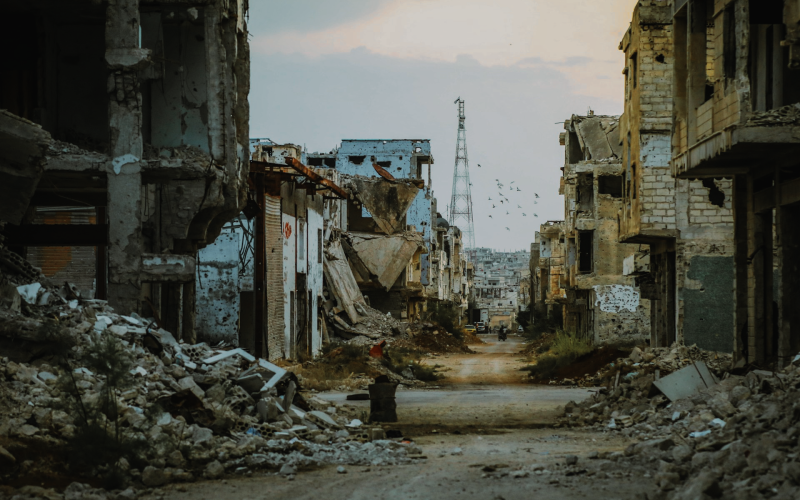Table of Contents Show
I. The Spark of Rebellion: A Nation on Edge
The Syrian Civil War did not emerge in a vacuum. Instead, it arose from the confluence of political repression, economic distress, and a yearning for democratic reform. By 2011, Syria was under the authoritarian rule of President Bashar al-Assad, whose regime had maintained a tight grip on power for over a decade. In the wake of the Arab Spring—a series of anti-government protests that swept across the Middle East—Syrians took to the streets, demanding greater freedoms, an end to corruption, and the release of political prisoners.
Initially, these protests were largely peaceful, echoing the calls for change that resonated in Tunisia, Egypt, and elsewhere. Young activists organized demonstrations in cities like Daraa, where security forces responded with brutal crackdowns. The government’s violent response not only fueled outrage but also radicalized segments of the population. Within months, the protests transformed from peaceful demonstrations into an armed rebellion.
As the conflict escalated, the landscape of the rebellion became increasingly complex. The Free Syrian Army (FSA) emerged as a primary opposition group, composed mainly of defected soldiers and civilians armed to resist the regime. Yet, as the civil war unfolded, it became clear that the struggle was not merely against Assad’s rule; it was also a contest for the soul of Syria itself. Multiple factions began to vie for power, with differing ideologies and goals, leading to a multifaceted and chaotic conflict.
II. The Descent into Chaos: A War Without Borders
What began as a civil uprising quickly spiraled into a full-blown civil war, drawing in regional and global powers and transforming Syria into a battleground for competing interests. The involvement of foreign actors complicated an already complex situation. Iran and Hezbollah supported Assad’s regime, providing military assistance and resources, while Sunni Gulf states, including Saudi Arabia and Qatar, funneled weapons and funding to various rebel groups.
The introduction of extremist groups added another layer of complexity to the conflict. The rise of ISIS (Islamic State of Iraq and Syria) in 2013 marked a turning point. Capitalizing on the chaos, ISIS seized territory across Syria and Iraq, proclaiming a caliphate and committing horrific acts of violence against civilians, religious minorities, and even rival rebel factions. The brutality of ISIS not only drew international condemnation but also further alienated the already fragmented opposition.
As the war intensified, the humanitarian crisis deepened. Millions of Syrians were displaced, either internally or as refugees fleeing to neighboring countries and beyond. By 2021, the United Nations estimated that over 13 million people were in need of humanitarian assistance, with many living in besieged areas and facing dire conditions. The toll on civilians was staggering, with hundreds of thousands killed and countless others injured or traumatized. Cities lay in ruins, and a generation of children faced an uncertain future, deprived of education and stability.
III. The International Response: A Struggle for Influence
The international community’s response to the Syrian Civil War has been marked by indecision, moral quandaries, and competing narratives. The Obama administration initially adopted a policy of cautious engagement, framing the conflict as a humanitarian crisis while simultaneously providing limited support to moderate rebel factions. However, the lack of a coherent strategy led to frustration, as the war escalated and extremist groups gained ground.
The use of chemical weapons by Assad’s regime in 2013 was a pivotal moment, prompting global outrage and calls for intervention. Despite red lines being drawn, the U.S. response was tepid, leading to criticism that the West was failing to uphold its moral obligations. The decision to launch airstrikes against ISIS in 2014 marked a significant shift, as the U.S. sought to combat the extremist threat but still struggled to develop a comprehensive strategy for ending the war.
Russia’s intervention in 2015 dramatically altered the dynamics of the conflict. Supporting Assad with airstrikes and military resources, Russia sought to reassert its influence in the region and counter U.S. dominance. The Kremlin’s involvement effectively turned the tide in favor of Assad, as opposition forces found themselves facing a well-coordinated military campaign backed by a global superpower.
The competing interests of foreign nations complicated the prospects for peace. The ongoing military engagement of the U.S., Russia, Iran, and Turkey, coupled with the presence of various rebel factions and extremist groups, created a situation where the potential for a negotiated resolution seemed increasingly remote. Attempts at peace talks, including those facilitated by the United Nations, struggled to make meaningful progress, as the parties involved remained entrenched in their positions and objectives.
IV. The Human Cost and a Fractured Future
As the Syrian Civil War enters its second decade, the human cost continues to mount, and the prospects for resolution remain bleak. The conflict has decimated the country’s infrastructure and shattered the lives of millions. Education, healthcare, and basic services have been severely impacted, leading to a humanitarian crisis of staggering proportions.
The war has also led to a significant refugee crisis, with millions of Syrians seeking asylum in neighboring countries and Europe. Nations like Lebanon and Jordan have been strained by the influx, struggling to provide for their own citizens while accommodating refugees. The integration of Syrian refugees into host societies remains a contentious issue, often fueling social tensions and political backlash.
Moreover, the ongoing violence and instability have allowed extremist ideologies to take root. The presence of groups like ISIS, even in a diminished capacity, poses ongoing threats to regional security and global stability. As the international community grapples with the aftermath of the conflict, questions about accountability, reconstruction, and reconciliation loom large.
The future of Syria remains uncertain. The Assad regime, bolstered by foreign support, continues to cling to power, while opposition forces are fragmented and lack a unified vision. The country is likely to remain divided, with various regions under the control of different factions, leading to an enduring state of conflict and instability.
In conclusion, the Syrian Civil War stands as a tragic testament to the consequences of repression, the complexities of armed conflict, and the challenges of international intervention. It is a conflict that has reshaped the Middle East, challenged the international order, and left scars that will take generations to heal. As the world looks on, the plight of the Syrian people serves as a reminder of the urgent need for compassion, understanding, and a commitment to peace in the face of overwhelming adversity.










